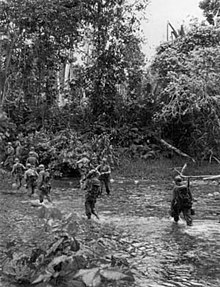| Landing at Saidor | |||||||
|---|---|---|---|---|---|---|---|
| Part of World War II, Pacific War | |||||||
 Troops of the 32nd Infantry Division near Saidor. | |||||||
| |||||||
| Belligerents | |||||||
|
|
| ||||||
| Commanders and leaders | |||||||
|
|
| ||||||
| Strength | |||||||
| 13,000 | 6,000 | ||||||
| Casualties and losses | |||||||
The landing at Saidor, codenamed Operation Michaelmas, was an Allied amphibious landing at Saidor, Papua New Guinea on 2 January 1944 as part of Operation Dexterity during World War II. In Allied hands, Saidor was a stepping stone towards Madang, the ultimate objective of General Douglas MacArthur's Huon Peninsula campaign. The capture of the airstrip at Saidor also allowed construction of an airbase to assist Allied air forces to conduct operations against Japanese bases at Wewak and Hollandia. But MacArthur's immediate objective was to cut off the 6,000 Imperial Japanese troops retreating from Sio in the face of the Australian advance from Finschhafen.
Following the landing at Saidor, the Japanese elected to retreat rather than fight, and withdrew over the foothills of the rugged Finisterre Range. For the Japanese soldiers involved, the march was a nightmare, as they struggled through the jungles, across the swollen rivers, and over cliffs and mountains. Men succumbed to fatigue, disease, starvation, drowning, and even exposure, the nights in the Finisterres being bitterly cold. Hampered by the rugged terrain, inclement weather, signal failures, misunderstandings, over-caution, and above all the resolute and resourceful Japanese, US troops were unable to prevent large numbers of the retreating Japanese from slipping past them.
After considerable construction effort in the face of wet weather, the airbase was completed and proved useful. Whereas the base at Nadzab was surrounded by mountains and was therefore unsuited for missions that had to take off after dark, there was no such problem at Saidor. During March 1944, B-24 Liberator bombers staged through Saidor for night attacks on Hollandia.
